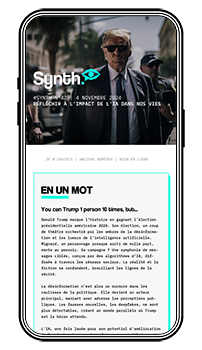Ce qu’on fait.
Journalism.design est un studio de production d’informations basé à Paris qui met l’accent sur l’innovation éditoriale. Espace de réflexion sur les futurs souhaitables du journalisme dans une société numérique en pleine croissance, journalism.design travaille sur les modes de production et de diffusion de l’info.
Journalism.design édite Synth et d’autres propositions éditoriales, propose des formations, des accompagnements médias et publie ses travaux de recherches.


SYNTH est un média éclaireur qui vous aide à garder un oeil critique sur la place de la tech et l’IA dans nos vies et nos imaginaires. Pour mieux comprendre les enjeux politiques, idéologiques, économiques, culturel et sociaux auxquels nous faisons face, abonnez-vous gratuitement à SYNTH.




